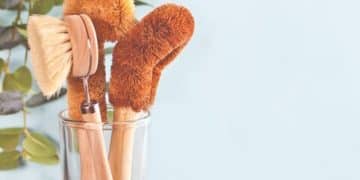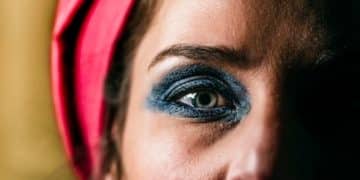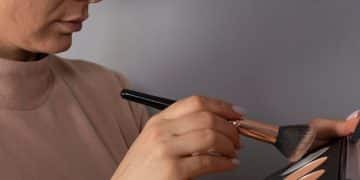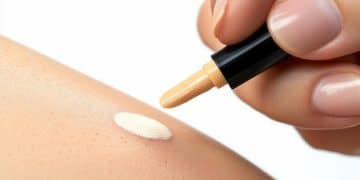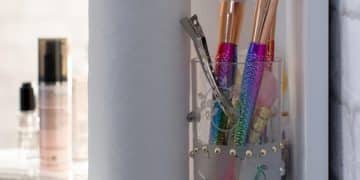Best Makeup Brushes for Every Application: A Guide
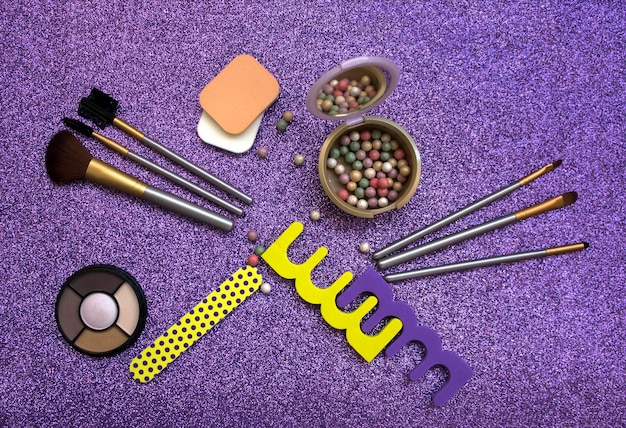
Anúncios
Choosing the right makeup brushes is essential for achieving a flawless application, with each brush type uniquely designed for specific products and techniques, ultimately enhancing your beauty routine.
Diving into the world of makeup can be both exciting and overwhelming, especially when it comes to tools. Understanding the best makeup brushes for every application: a comprehensive guide is pivotal for anyone looking to elevate their beauty routine from amateur to artist. The right brush not only makes a significant difference in how your makeup looks but also in how effortlessly it applies. This guide aims to demystify the vast array of options available, ensuring you select the perfect companions for your cosmetic collection.
Anúncios
Understanding the Foundation: Brush Materials and Construction
Before exploring specific brush types, it’s crucial to grasp the fundamental elements that constitute a quality makeup brush: its bristles, ferrule, and handle. These components jointly determine a brush’s performance, durability, and ergonomic comfort, significantly influencing the application. High-quality materials contribute to a smoother, more even makeup finish and ensure the brush lasts longer with proper care.
The choice between natural and synthetic bristles is often the first decision. Natural bristles, typically made from animal hair like goat, squirrel, or sable, are prized for their ability to pick up and distribute powder products smoothly, creating a soft, diffused effect. They have a natural cuticle that allows them to hold powder pigments effectively. Synthetic bristles, on the other hand, are usually made from nylon or other man-made fibers. These are ideal for liquid, cream, and gel formulas due to their non-porous nature, which prevents product absorption and allows for a more precise, streak-free application. Modern synthetic brushes have advanced significantly, often mimicking the softness and performance of natural hair while being more durable, easier to clean, and cruelty-free.
The Importance of Brush Aesthetics
While often overlooked, the ferrule—the metal part connecting the bristles to the handle—and the handle itself play vital roles. A well-constructed ferrule made of sturdy metal, often copper or aluminum, will securely hold the bristles in place, preventing shedding and ensuring the brush maintains its shape over time. A crimped ferrule indicates a more secure attachment. The handle, commonly made from wood, plastic, or acrylic, should feel comfortable and balanced in the hand, allowing for controlled and effortless application. Handle length and thickness vary, catering to different preferences and application styles. Some prefer shorter handles for precision work, while others opt for longer ones for broader strokes.
Anúncios
- Bristle Quality: Affects product pick-up and distribution.
- Ferrule Integrity: Prevents shedding and maintains brush shape.
- Handle Ergonomics: Ensures comfortable and controlled application.
Ultimately, investing in brushes with superior materials and construction is a wise decision. Such brushes not only enhance the user experience but also contribute significantly to the longevity of the tools and the professional finish of your makeup. Understanding these foundational aspects empowers you to make informed choices beyond just the brush’s intended use.
Face Brushes: Sculpting and Perfecting Your Canvas
The foundation of any makeup look begins with a well-prepped face, and the right array of face brushes can transform your complexion. From applying foundation and concealer to setting powder and bronzer, each brush is designed to perform a specific task, ensuring a seamless and natural finish. The variety in shapes, sizes, and density of these brushes directly impacts the coverage and blend of your face makeup.
Foundation and Concealer Brushes
For foundation, several brush styles cater to different preferences and product consistencies. A flat-top kabuki brush provides dense coverage and buffs liquid or cream foundation into the skin for an airbrushed finish, ideal for full coverage. Tapered brushes, on the other hand, offer more controlled application and are excellent for blending foundation into hard-to-reach areas around the nose and eyes. Damp beauty sponges can also be used for a lighter, more natural finish. For concealer, smaller, more precise brushes are key. A flat, synthetic concealer brush allows for targeted application to blemishes or dark circles, while a fluffy blending brush can seamlessly diffuse the product into the skin, preventing visible lines. The compact size of these brushes ensures better control over smaller, delicate areas of the face.
- Flat-top Kabuki: Ideal for full-coverage liquid foundation.
- Tapered Foundation Brush: Precision and blending for liquids/creams.
- Small Flat Concealer Brush: Targeted application for spot concealing.
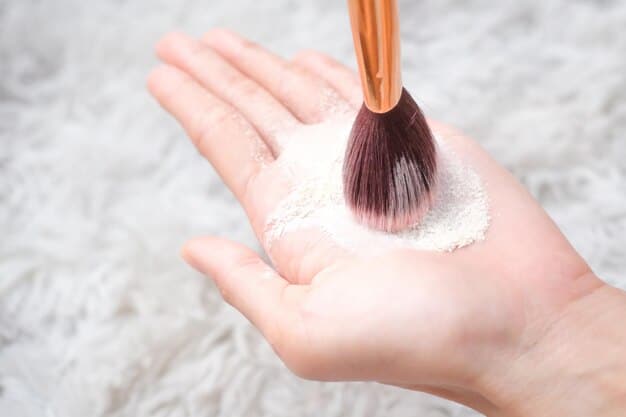
Powder, Blush, and Bronzer Brushes
Once your base is set, powder brushes come into play to diminish shine and set makeup. Large, fluffy powder brushes are perfect for dusting loose or pressed powder evenly across the face, providing a light veil of coverage without disturbing the underlying layers. For blush, a medium-sized, slightly tapered or angled brush is often preferred, allowing for precise application on the apples of the cheeks and effortless blending upwards towards the temples. Bronzer application benefits from a brush that can distribute color broadly and smoothly. A large, fluffy, angled bronzer brush is excellent for sculpting the face, applying color to the hollows of the cheeks, temples, and jawline, creating a sun-kissed glow. Some prefer a rounded, dense brush for a more intense contour effect when it comes to bronzer.
The art of applying face makeup lies in blending. Regardless of the product, always blend in small, circular motions or gentle sweeping strokes to avoid harsh lines. Regular cleaning of face brushes is also critical to prevent bacterial build-up and ensure smooth, hygienic application.
Mastering these face brushes ensures a uniform, perfected skin appearance, ready for the next steps of your makeup routine. Each brush plays a crucial role in building the desired level of coverage and enhancing facial features subtlety.
Eye Brushes: Defining and Illuminating Your Eyes
The eyes are often the focal point of any makeup look, and the right collection of eye brushes is indispensable for creating everything from a subtle everyday enhancement to a dramatic smoky eye. Eye brushes come in an extensive array of shapes and sizes, each meticulously designed to handle different eyeshadow formulas, liners, and brow products with precision. Their smaller scale and specialized shapes enable intricate detailing and seamless blending.
Eyeshadow and Blending Brushes
For eyeshadow application, a fundamental trio often includes a flat shader brush, a fluffy blending brush, and a pencil brush. A flat shader brush, typically dense with short, firm bristles, is ideal for packing eyeshadow onto the eyelid, delivering intense color payoff. It’s particularly effective for shimmers and metallics. Once the color is applied, a fluffy blending brush—often dome-shaped with soft, longer bristles—becomes your best friend. This brush is crucial for diffusing harsh lines, softening edges, and seamlessly blending different shades together in the crease and outer corner, creating a gradient effect. A tapered blending brush offers even more precision for detailed blending in the crease. Lastly, a pencil brush, with its small, pointed tip, is perfect for smudging eyeliner, applying shadow to the lower lash line, or highlighting the inner corner of the eye with precision.
- Flat Shader Brush: For packing color onto the lid.
- Fluffy Blending Brush: Diffuses harsh lines and blends shades.
- Pencil Brush: Precision for lower lash line and inner corner.
Eyeliner and Brow Brushes
Eyeliner application demands specialized brushes for crisp lines and controlled artistry. An angled eyeliner brush, with its fine, stiff bristles cut at a sharp angle, is excellent for applying gel, cream, or powder eyeliners along the lash line. Its shape allows for precise control, whether creating a thin, subtle line or a dramatic wing. A very fine-tipped brush, often called a detail or thin liner brush, is suitable for liquid liners or creating ultra-fine lines. For brows, an angled brow brush paired with a spoolie is the ultimate duo. The angled brush allows for precise application of brow powders or pomades, mimicking natural hair strokes, while the spoolie on the other end helps to comb through brow hairs, blend product, and tame unruly strands for a polished look. Some brushes come with a double-ended design, offering both the angled brush and spoolie for convenience.
The key to successful eye makeup lies in patience and understanding the function of each brush. Don’t be afraid to experiment with different shapes to discover what works best for your eye shape and desired outcome. Always remember to clean your eye brushes regularly to prevent cross-contamination of colors and maintain hygienic application.
Ultimately, a well-curated set of eye brushes empowers you to unleash creativity and achieve stunning, professional-looking eye makeup with ease and precision.
Lip Brushes: Achieving Precision and Definition
Lip makeup, while sometimes seemingly straightforward, can be elevated significantly with the use of dedicated lip brushes. These tools are indispensable for achieving crisp lines, even color application, and custom shades that transform your pout into a work of art. Unlike applying lipstick directly from the bullet, a lip brush provides unmatched control and precision, making any lip product look more polished and long-lasting.
Application and Blending
The primary function of a lip brush is to apply lipstick, lip gloss, or lip stains with extreme accuracy. Most lip brushes feature a small, firm, and often tapered shape, making them ideal for tracing the natural lip line or overdrawing slightly for a fuller appearance. The firm bristles allow for a smooth and controlled glide, ensuring the product settles evenly without feathering. For those who enjoy mixing lip colors to create custom shades, a lip brush is essential. It enables you to blend different lipsticks on the back of your hand before applying, ensuring a uniform and unique color. Furthermore, a lip brush can help prolong the wear of your lipstick by allowing you to press the product into the lips rather than just laying it on top.
- Precision Application: Defines the lip line with accuracy.
- Even Color Distribution: Ensures uniform coverage.
- Custom Blending: Ideal for mixing and creating unique shades.
Some lip brushes come with a cap, making them travel-friendly and protecting the bristles from damage and contamination. Opting for synthetic bristles in a lip brush is often preferred as they are easier to clean and do not absorb the product, making them hygienic for repeated use with various lip colors. The ability of a lip brush to reach into the smallest corners of the lips ensures no spot is missed, providing a complete and refined finish.
Beyond liquid or cream lip products, lip brushes can also be used with lip pencils to soften harsh lines or fill in the entire lip for a matte, long-wearing base. This versatility makes them a valuable addition to any makeup kit, especially for those aiming for a high-definition lip look.
In essence, a lip brush transforms the ordinary act of applying lipstick into a precise art form, ensuring that every curve and line of your lips is perfectly defined and colored, resulting in a flawless and captivating smile.
Specialty Brushes: Enhancing Specific Features and Techniques
Beyond the core lineup of face, eye, and lip brushes, a fascinating array of specialty brushes exists, each meticulously designed to address specific makeup needs or to perfect advanced application techniques. These brushes often have unique shapes, bristle densities, or angles that set them apart, allowing for unparalleled precision and a truly customized makeup outcome. Incorporating a few select specialty brushes can significantly elevate your makeup artistry.
Highlighting and Contouring Brushes
Achieving a sculpted and luminous complexion relies heavily on the right highlighting and contouring tools. For highlighter application, a fan brush is a popular choice due to its light, feathery bristles that dust shimmer onto the high points of the face—cheekbones, brow bone, and cupid’s bow—without over-applying. Some prefer a tapered brush with a slight point for a more targeted highlight, especially for the nose bridge or inner corner of the eye. For contouring, an angled contour brush fits perfectly into the hollows of the cheeks, allowing for a precise application of contour powder or cream. A small, dense brush can also be used for nose contouring, allowing for accurate shading and blending for a refined sculpted effect. The key is to select a brush that allows for diffusion of product to avoid harsh lines.
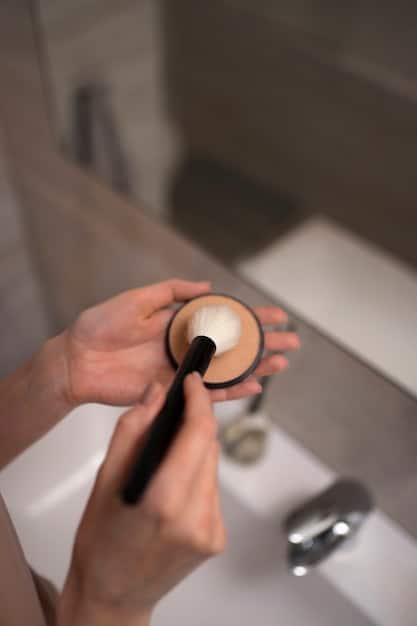
Detail and Correction Brushes
For fine-tuning and correcting mistakes, detail brushes become invaluable. A small, flat synthetic brush, often referred to as a “flat definer” or “concealer brush,” can be used with concealer to sharpen eyeliner wings, clean up lipstick edges, or precisely cover small blemishes. Its firm, straight edge is perfect for creating crisp lines. An even tinier, pointed brush can be utilized for intricate eye details, such as applying inner corner highlight, spot correcting, or creating graphic liner designs with high precision. These brushes are also excellent for applying glitter or individual false lashes, offering control where larger brushes would be cumbersome. Additionally, some specialty brushes are designed for color correction, applying specific color correctors to target redness or dark spots before foundation, ensuring a seamless and neutralized base.
While not every specialty brush is a necessity for daily makeup, strategic additions to your collection can significantly enhance advanced techniques and help you achieve a more refined and professional finish. It’s about finding the tools that genuinely serve your specific makeup goals and preferences. Experimentation is encouraged to discover which unique shapes simplify your routine or enable new creative expressions.
Ultimately, specialty brushes are the secret weapons in a makeup artist’s arsenal, allowing for meticulous application and targeted beauty solutions that cater to every unique facial feature, ensuring every detail is perfected with ease.
Care and Maintenance: Prolonging the Life of Your Brushes
Owning a collection of high-quality makeup brushes is an investment, and just like any valuable tool, they require proper care and maintenance to ensure their longevity, cleanliness, and optimal performance. Regular cleaning not only preserves the integrity of your brushes but also protects your skin from bacteria buildup, which can lead to breakouts or irritation. A consistent cleaning routine is paramount for both hygiene and effective makeup application.
Daily and Deep Cleaning Routines
For daily maintenance, especially with liquid or cream products, wiping your brushes on a clean towel or a quick-drying brush cleaner after each use can prevent product buildup and maintain hygiene between deep cleans. This immediate wipe-down is particularly important for brushes used with foundation and concealer to avoid product drying and hardening on the bristles. For a more thorough cleansing, a deep cleaning routine should be performed weekly or bi-weekly, depending on usage. This involves using a gentle brush shampoo or a mild soap (baby shampoo is a popular choice) and lukewarm water. Wet the bristles, apply a small amount of cleanser, and gently swirl the brush on a cleaning mat or the palm of your hand until the lather runs clear. Rinse thoroughly, ensure no soap residue remains, and reshape the bristles before laying them flat or hanging them upside down to dry to prevent water from seeping into the ferrule, which can weaken the glue and cause shedding.
- Daily Cleanse: Quick wipe-down to prevent buildup.
- Weekly Deep Clean: Thorough wash with gentle soap/shampoo.
- Proper Drying: Lay flat or hang bristles-down to protect ferrule.
Proper storage is also crucial. Storing brushes upright in a cup or laid flat in a drawer can protect their shape and prevent bristles from bending. Avoid storing them in damp environments, like a closed humid bathroom, as this can encourage bacterial growth. Investing in brush guards can also help maintain the shape of your fluffy brushes while drying or when traveling, preventing them from splaying out and losing their form. Additionally, being gentle during both washing and drying processes is vital; never tug or pull excessively on the bristles, as this can cause permanent damage or shedding.
By adhering to a consistent and proper care routine, your makeup brushes will remain in pristine condition, offering countless applications of flawless makeup. This commitment to maintenance extends the lifespan of your investment and ensures that every stroke is as effective and hygienic as the first.
Ultimately, a well-maintained brush collection isn’t just about appearance; it’s about optimizing performance, ensuring hygiene, and protecting your investment in quality tools that enhance your overall beauty experience for years to come.
Building Your Ideal Brush Collection: Tips for Every Budget
Assembling a comprehensive and effective makeup brush collection doesn’t have to be daunting or expensive. Whether you’re a beginner or a seasoned makeup enthusiast, the key is to prioritize quality over quantity and to select brushes that genuinely meet your specific needs and application preferences. Building your ideal brush collection is a journey that can be tailored to any budget, from high-end luxury sets to affordable yet effective options.
Prioritizing Essential Brushes First
When starting, focus on acquiring a few versatile, multi-purpose brushes rather than a vast array of specialized ones. A good starting point typically includes a versatile foundation brush (like a flat-top kabuki or a blending sponge), a fluffy powder brush, a medium-sized blush/bronzer brush, and a couple of essential eye brushes—a flat shader for applying color and a fluffy blending brush for diffusing harsh lines. These core brushes can tackle most everyday makeup applications effectively. Once you’re comfortable with these basics, you can gradually expand your collection, adding specialty brushes as your skills advance or as specific needs arise, such as a precise eyeliner brush or a small detail brush for intricate work. There are many affordable brands that offer excellent quality brushes that perform just as well as their more expensive counterparts, making good makeup tools accessible to everyone.
Consider synthetic brushes for versatility, as they work well with both liquid/cream and powder formulas, and are often easier to clean and more durable. If your budget allows, a mix of natural brushes for powder products and synthetic for liquids can offer the best of both worlds. Look for sets offered by reputable brands, as these often provide a better value than purchasing individual brushes. However, if a set includes brushes you know you won’t use, it might be more cost-effective to buy individual brushes that precisely meet your requirements.
Strategic Investment and Budget-Friendly Options
Investing strategically means putting more of your budget towards brushes you use most frequently, or those that significantly impact the outcome of your makeup. For instance, a high-quality foundation brush or a staple blending brush for eyeshadow might be worth a slightly higher investment due to their constant use and impact on the overall finish. For other less-frequently used brushes, more budget-friendly alternatives can be perfectly adequate. Online reviews and beauty community recommendations can be invaluable resources in identifying hidden gems and effective dupes for high-end brushes. Many drugstores and online retailers now offer surprisingly good quality brushes that defy their price tags, proving that effective makeup application is attainable without breaking the bank.
No matter your budget, remember that the best brush is one that feels comfortable in your hand, applies product smoothly, and helps you achieve your desired look with ease. Regular cleaning and proper care of your brushes, regardless of their cost, will always be the most important factor in prolonging their life and ensuring their peak performance.
Ultimately, building your ideal brush collection is a personal journey, focusing on functionality, quality, and a smart approach to spending, ensuring you have the right tools to express your unique beauty creatively and effectively.
| Key Point | Brief Description |
|---|---|
| ✨ Material Matters | Natural bristles for powder, synthetic for liquids/creams. |
| 🎨 Application Specifics | Different brushes for face, eyes, lips, and specialized techniques. |
| 🧼 Proper Care | Regular cleaning extends brush life and ensures hygiene. |
| 💰 Budgeting Tips | Prioritize versatile essentials; expand gradually with quality over quantity. |
Frequently Asked Questions About Makeup Brushes
For brushes used with liquid or cream products (like foundation and concealer), it’s best to clean them after every use to prevent buildup and bacterial growth. Brushes used for powder products can be deep cleaned weekly or bi-weekly, depending on how often they are used, to maintain hygiene and performance.
Natural bristles, typically from animal hair, are ideal for powder products as their cuticles pick up and distribute pigment smoothly. Synthetic bristles, made from man-made fibers, are non-porous and better suited for liquid, cream, and gel formulas, ensuring these products don’t absorb into the brush for a streak-free application.
While some versatile brushes can be used for more than one purpose (e.g., a powder brush for both setting powder and blush), it’s generally best to use dedicated brushes for different products. This prevents color mixing, maintains product integrity, and ensures a cleaner, more precise application, especially for eye makeup.
After washing, gently squeeze excess water from the bristles and reshape them. Lay brushes flat on a clean towel or hang them upside down to dry. This prevents water from seeping into the ferrule (the metal part), which can weaken the glue and cause bristles to shed. Avoid drying them upright.
Investing in higher-quality brushes can be beneficial as they often offer superior performance, durability, and a smoother application experience. However, there are many excellent, affordable options available. Focus on key, frequently used brushes for potential investment, and supplement with budget-friendly alternatives for less frequent uses.
Conclusion
Navigating the world of makeup brushes can seem complex, but armed with the right knowledge, it becomes an empowering journey. From understanding the nuances of bristle types to mastering the specific applications of face, eye, and lip brushes, selecting the best tools significantly enhances your makeup artistry. Remember, proper care and maintenance are just as crucial as the initial investment in ensuring your brushes perform flawlessly and remain hygienic for years to come. By prioritizing quality, versatility, and strategic budgeting, anyone can build an effective and personalized brush collection that transforms their beauty routine.
